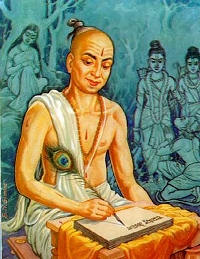Many centuries after it was written, the Raamaayan remains one of the most renowned texts in the religious and literary world. This ancient Sanskrit epic is credited to the Hindu sage, Vaalmiki. In the 16th century, Goswaami Tulsidas (c.1523-1623), a Hindu poet and saint, reformer and philosopher, known for his devotion to Shree Raam, rewrote Sage Vaalmiki’s epic in Avadhi, a language similar to Hindi, making it more understandable for the population. It was renamed Shri Raamcharitramaanas (The Lake of Shree Raam’s Deeds). Shree Tulsidasji was a composer of several popular works, and is the author of the Hanumaan Chalisa, the popular religious ode to Shree Hanumaan, the devotee of Raam. Tulsidas’ birth is commemorated on August 17, 2018.
Today, Tulsidas is revered as one of the greatest poets in the literary world. However, before he gained veneration, he had to overcome many challenges. Tulsidas was born to Hulsi and Atmaram Dubey in the year 1532 in Uttar Pradesh, India. He is said to be an incarnation of the original author of the Raamaayan, Sage Vaalmiki. Tulsidas lost his parents early in life and survived under the most impoverished conditions. The first word Tulsidas uttered as a child was “Raam”. Consequently, he was also known as Ram Bola by the villagers. A turning point in his life was meeting his Guru Narahari Das, whom Tulsidas considered his preceptor. The Guru steered him on the road to gyaan bhakti (enlightened devotion) and shuddh karma (pure action). From him, Tulsidas acquired knowledge of the Hindu scriptures.
Tulsidas eventually renounced his family ties and became an ascetic. His devotion to Shri Ram was unequalled and his spiritual quest led him on long pilgrimages across India, where he encountered severe obstacles. It is said that an emperor, who had heard of the greatness of Tulsidas, demanded that he perform a miracle but Tulsidas said to him, “I have no superhuman power. I know only the name of Raam.” Angered by this statement, the emperor imprisoned Tulsidas. With unwavering faith, Tulsidas prayed to Shri Hanumaan. Many monkeys entered the emperor’s court and the emperor then believed that Tulsidas was a saint. His writing of the Shree Raamcharitramaanas also met with great opposition from other Sanskrit scholars who condemned both the text and the writer. Tulsidas’ quest for the Lord grew in intensity with every illness, every obstacle or disappointment that confronted him to the end of his days.
The Shree Raamcharitramaanas consists of seven volumes or kaand: Baal Kaand (Childhood Episode), Ayodhaa Kaand (Ayodhaa Episode), Aranya Kaand (Forest Episode), Kishkindhaa Kaand (Kishkindhaa Episode), Sundar Kaand (Beautiful Episode), Lanka Kaand (Lanka Episode) and Uttar Kaand (Answer of Perfection Episode). Tulsidas began and ended every chapter with an invocation because he believed that the writing and reading of the epic required the right frame of mind and the divine assistance of God.
In the Shree Raamcharitramaanas, Shree Raam, an incarnation of Lord Vishnu, is manifested in the home of King Dasrath and Queen Kaushalya in Ayodhya. Many are the reasons given for this divine manifestation: putting an end to the reign of terror by Ravan, King of Lanka; bringing fulfilment of Sage Narad’s words and responding to the call of Manu and Shatrupa to re-establish the law of righteousness that had degenerated.
This incarnation of the Lord, his leelas (divine activities) on earth and the idealism He symbolises, provides us with a guide for our own spiritual journey. Shree Raam is representative of the state of spiritual perfection that is derived after the spiritual aspirant traverses through the jungle of the material world, defeating the limited human personality, represented by Ravan, and returning to Ayodhya, where he experiences Raam Raajya or perfection.
Abstract philosophical ideas are fully described through the characters. Sita Devi is representative of the intellect that is kidnapped by Ravan, the unrestrained ego. Lakshman, Bharath and Shatrughan represent respectively, the powers of concentration, devotion and action that assist us in reaching the Divine. King Dasrath of Ayodhya symbolises the ten senses inherent in man: the five senses of perception and the five organs of action. His three queens, signify the nature or qualities that guide human behaviour: Queen Kaushalya (sattva or truth, piety and goodness), Queen Kaikeyi (rajas or materialism and action) and Queen Sumitra (tamas or inertia). The city of Ayodhya represents the human body. When the senses are controlled, then yagya or sacrifice can be performed. Resulting from this purificatory process, the solution, in the form of kheer, can be obtained.
The offspring of the queens symbolise the pathways to divinity: from Queen Kaushalya, Raam represents gyaan yoga; from Queen Sumitra, Lakshman represents dhyaan yoga and Shatrughan, karma yoga; from Queen Kaikeyi, Bharath represents bhakti yoga.
The city of Lanka is representative of the psychological state. The destruction of Ravan, Kumbhkaran and other demons, and the coronation of Vibheeshan, symbolise the reign of truth over materialism and sluggishness.
In this way, Tulsidas’ greatest contribution to humanity, Shree Raamcharitramaanas, is said to be an in-depth treatise on life that explores human values and the concept of dharma or righteous living and provides us with a map to reach the Divine.



